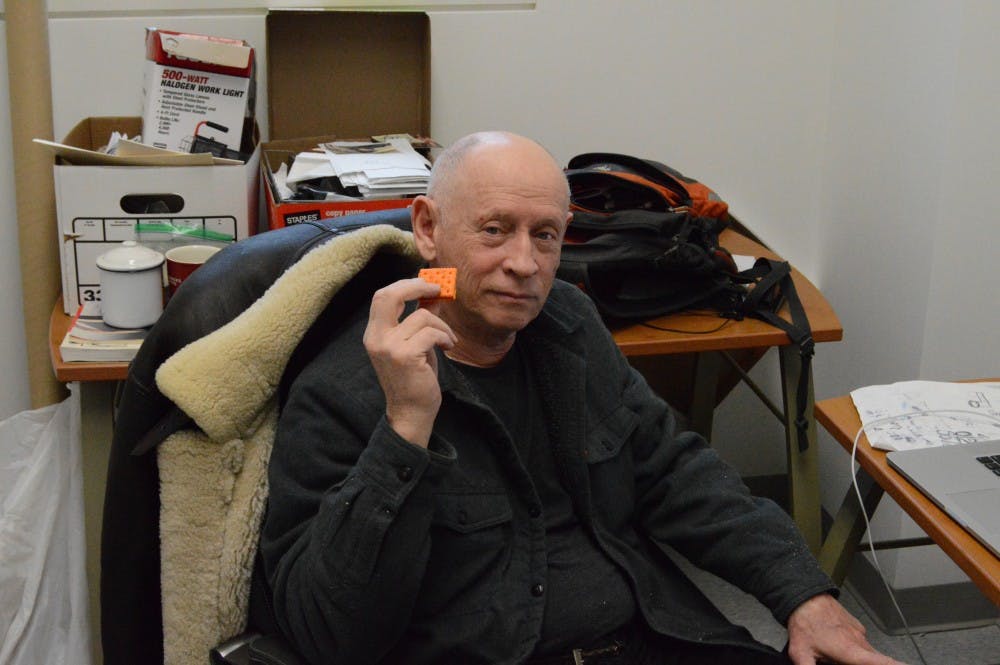The image of a fractured iceberg in a sea of blood leans on an office wall in the Center for the Arts.
The piece, “End of Days,” symbolizes ice caps melting under man-made forces causing environmental destruction.
The artist is the politically outspoken head of the UB painting program, David Schirm.
Schirm grew up in a mining town, served in Vietnam and suffered from post-traumatic stress disorder years after coming home. Schirm, as he approaches 74, maintains a laid-back personality with a fun sense of humor. He is the recipient of two Fulbright Fellowships and has been showcased at local exhibitions like the Albright-Knox Art Gallery and traveling exhibitions like Lucy Lippard’s “A Different War.”
Schirm will leave behind a faculty moved by his work as he approaches retirement in January 2020.
He was born in 1945 in Pittsburgh, Pennsylvania. His father got a house in a mining town called Coal Hollow just outside of the city, following the 1944 GI Bill. He remembers it as a depressing area where people “mined coal in their backyards.” People would take a mule and a cart into the tunnel’s depths and mine coal for a living.
Schirm said making art and playing with building blocks were his favorite activities since kindergarten. He took art classes at Carnegie Museum of Art at age 10. He produced a drawing that earned him a full scholarship, according to Schirm. He said, if an artist’s drawing was “good,” the people who ran the museum chose the artist for an on-stage recreation in colored chalk.
His mother, who worked a job in dry cleaning, kept the drawing for her whole life.
Schirm received a full scholarship to attend Carnegie Mellon University, where he would receive his BFA in painting.
Schirm enlisted to serve in the Vietnam War shortly after. He served for two years before coming home in 1969. Schirm said he considered his service a type of, “rite of passage.” He no longer had an affinity for the war after serving.
“[Other soldiers] had a real curiosity about [the war] and to me, it was something to kind of get over,” he said. “You’d see people … who were f––––d up. I mean legs gone, arms gone. I’d meet somebody in a store who’s got scars all over their face … it does leave a big effect on you.”
Schirm said he was initially supposed to go to the U.S. Military Assistance Command, Vietnam headquarters, but earned a construction job since he had a college education.
He sketched minefields in Vietnam, created groundwork art and made going-away presents for officers he knew. The Vietnamese in the area knew Schirm was an artist and made him a giant palette out of plywood, which he thought was “hysterical.”
Of the 500 people in his battalion, Schirm was the only one who wasn’t offered reenlistment, he said.
Schirm said the military lost his pay records and paid for a first-class seat for his standby flight back to the U.S.
He threw his uniform down an incinerator after landing and went to a Washington D.C. protest march, where over 500,000 people attended, Schirm said.
Schirm did not sustain severe injuries but was diagnosed with PTSD and Agent Orange disability. It took two years for Schirm to regain his sense of humor and years longer to fully adjust to civilian life.
“I was looking through a window of an antique store in some little town outside of Philadelphia and a chill went through me when I realized I had dropped my guard,” Schirm said. “I was always aware of everything coming down the street two hundred yards.”
He then earned his Master’s of Fine Arts at Indiana University and returned to CMU to teach painting and lecture at various colleges and universities before finally coming to UB.
Schirm, in 1985, met the late Duayne Hatchett, who propelled Schirm into his future career as the head of the painting program. Hatchett was the head of the sculpting program and Schirm holds him in high regard.
Paul Vanouse, now the department head of emerging practices in art, was a student at UB from 1985 to 1990. He chose painting for undergraduate school, enrolled in Schirm’s basic painting class and worked on independent studies for most of those years.
“It was quite a shift from what I knew of painting from high school,” Vanouse wrote in an email. “The first assignment was simply to find a 24-inch square area of the painting room floor and attempt to recreate it on canvas, which is more challenging than it might seem.”
Emily Quartley, a sophomore studio art major, took Schirm’s basic painting class in the fall semester. She described him as a friendly, eccentric professor who would both help students and jokingly yell at them if they did something wrong.
“There was one day where he thought that everybody was using too much paint on their palettes,” Quartley said. “So he just went to every single person's palette and pointed to individual globs of paint and just screamed, ‘Too much paint.’”
Joan Linder, chair of the art department, met Schirm in 2004 when she first joined the department. Linder wrote that she thoroughly enjoyed working with Schirm.
“I will miss Dave, especially his sense of humor,” Linder wrote in an email. “I am also excited for him to start the next chapter of his life.”
Schirm will take a research leave next semester before he retires. He is planning a family trip to Italy and a move to Greenfield, Massachusetts with his wife.
Schirm plans on making art to showcase at exhibitions. He’s currently working on drawings based on a novel called “The Sorrow of War” by Bảo Ninh. The book is based on the author’s experience as a soldier for the North Vietnamese during the war.
Schrim said he hopes to have 20 drawings finalized for a showcase.
Cian Gonzalez is a staff writer and can be reached at features@ubspectrum.com.





